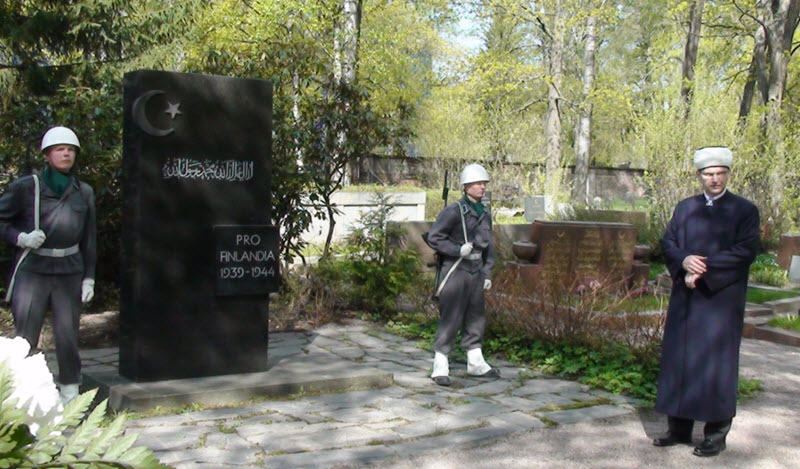
The Tatars of Finland are a group of roughly one thousand Finnish citizens hailing from the Volga Tatars. They still speek Mishar Tatar and belong to the Sunni Islam faith, and have retained many other aspects of their Volga Tatar culture despite living in Finland for multiple generations.
Most of them live in or around Helsinki, and the group forms a well-established community and operate the Finnish Islamic Congregation. The Finnish Tatars are one of the oldest extant Muslim minority groups in the Nordic countries.
Nowadays, it is very common for Finnish Tatars to speak Finnish and/or Swedish in addition to Mishar Tatar. (Swedish is one of Finland’s official languages.)
Name
On this page:
Tatar: Финляндия татарлары
English: Finnish Tatars
Finnish: Suomen Tataarit
Swedish: Finländska Tatarer
Background
Early Tatars in Finland
In 1809-1917, what we today known as sovereign Finland was the Grand Duchy of Finland, an autonomous part of the Russian Empire under the Tsar. During the early part of this era, Tatars came to Finland to work at Russian-run construction projects, particularly the building of the Bomarsund fortress on the island Åland and the Suomenlinna sea fortress on six islands scattered off the coast of Helsinki.
A majority of these Tatars eventually returned back to Russia, but some did not. Of those that never went back, some are burried at an Islamic cemetary in Bomarsund.

The 1870s – to mid 1920s
The early Tatars in Finland described above did not form any long-lasting multi-generational community on Finnish soil. The Tatars of Finland that live here today are instead the descendants of Tatars that arrived to Finland from the 1870s to the mid-1920s.
These Tatars hailed from a group of villages (roughly 20 or so) located along the Volga River in the Sergachsky District, southeast of Nizhny Novgorod. Most of them were farmers while still in Sergachsky, but came to Finland as merchants trading in furs and textiles. They went to Helsinki since that was a center of commerce, and eventually settled in or near the city.
Some Tatars instead settled in the city Vyborg on the Karelian Isthmus. When that area became a part of the Soviet Union at the signing of the Moscow Peace Treaty in 1940, they did not want to stay and become soviet subjects, so they moved to Helsinki by the coast or Tempere in the Finnish inland. In 1943, a muslim congregation for Tatars was formed in Tampere.
Finnish Tatars in today’s Finland
Today’s Finnish Tatars are fully integrated into Finnish society and holds a wide range of professions and positions. Remarkably, they have at the same time managed to preserve so much Tatar language proficiency, culture and religion – despite being such a small group.
Once upon a time, the community published quite a lot of novels, poetry, plays, religious texts, and even periodicals in the Tatar language, but this has now largely ceased. Still, the language is kept alive through private usage and many cultural activities that are arranged throughout the year.
The Finnish Islamic Congregation
The Finnish Freedom of Religion Act was adopted in 1922, and the Finnish Islamic Congregation (Tatar: Finlandiya Islam Cemaati. Finnish: Suomen Islam-seurakunta. ) was founded three years later.
The congregation is an important organisation for maintaining the culture and religious belief system of the Tatars in Finland, and it runs mosques in Helsinki and the town Järvenpää. There are also Tatar Islamic cemeteries in Helsinki, Turku (Åbo) and Tempere.
So far, the Järvenpää mosque is the only mosque in all of Finland that was originally built to be a mosque. Made out of wood, it is located roughly 30 km outside Helsinki and has been in use since 1942. There is a small minaret, but it is not actually utilized to call to prayer.
All muslims are welcome to worship at the Tatar mosques in Finland, but non-Tatars can not become members of the Finnish Islamic Congregation.
The Tatar Cultural Society
Since its foundation in 1935, the Tatar Cultural Society in Finland has arranged cultural events in the Tatar language, such as theatrical performances and poetry recitals. The society also help preserve and develop Tatar folk music and folk dancing. It is supported by the Finnish Islamic Congregation.
Yolduz
The Finnish Tatar community founded the sports club Yolduz in 1945, with support from the Finnish Islamic Congregation. The most well-known part of the club is the football team, which fostered the footballer Atik Ismail (born 1957) who went on to play 26 matches in the Finland national football team. He also played in the Finnish premier division Mestaruussarja and was the top scorer there in 1978, 1979 and 1982. Ismail’s two sons Ali and Pele are two other examples of Tatar footballers in the Finnish premier division.
Tatar Primary School
From 1948 to 1969, there was a Tatar primary school in Helsinki; partly subsidised by the City of Helsinki and partly by the Finnish Islamic Congregation. This was a bilingual school, where both Tatar and Finnish was used.
The primary school was later replaced with an after-school program where the Finnish Islamic Congregation held classes in Tatar language, culture, history, and religion.
Today, summer courses in Tatar are held at the Tatar Training Center in Kirkkonummi, just outside the Helsinki Metropolitan Area.
Tampere
As mentioned above, most Tatars in Finland settled in the Helsinki area, but some instead opted for the city Vyborg on the Karelian Isthmus.
When that area became a part of the Soviet Union at the signing of the Moscow Peace Treaty in 1940, they did not want to stay and become soviet subjects, so they moved to Helsinki or to Tempere, a city in the Finnish inland. This explains why there is a Tatar community in Tempere. As early as 1943, a muslim congregation for Tatars was formally founded there, and there is also a Tatar Islamic cemetery present in the city.
